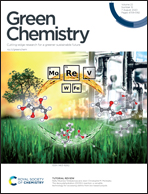Chitin hydrolysis in acidified molten salt hydrates†
Abstract
At present, there is a lack of green protocols to hydrolyze chitin into its monomer using a chemical approach. In this study, we establish acidified lithium halide molten salt hydrate (AMSH) systems to effectively convert native chitin into N-acetyl glucosamine (NAG). 71.5% NAG was achieved in 60 wt% LiBr AMSH containing only 40 mM HCl at 120 °C after 30 min. Kinetic investigations indicated the superacidic property of LiBr and LiCl AMSHs to be the key for the fast cleavage of β-1,4-glycosidic linkages, leading to NAG and oligomer formation with a significantly reduced amount of acid used. In parallel, comparative studies of chitin and chitin–salt composites using 13C NMR and ATR-IR techniques revealed the critical role of Li+ in the disruption of the hydrogen bonding network of chitin along with O![[double bond, length as m-dash]](https://www.rsc.org/images/entities/char_e001.gif) C on the acetamido group therefore promoting chitin swelling and dissolution. For these two reasons, lithium halide salts are superior to other salts screened, including ZnCl2, KCl, KBr, MgCl2, NaCl and NaI, for chitin hydrolysis.
C on the acetamido group therefore promoting chitin swelling and dissolution. For these two reasons, lithium halide salts are superior to other salts screened, including ZnCl2, KCl, KBr, MgCl2, NaCl and NaI, for chitin hydrolysis.



 Please wait while we load your content...
Please wait while we load your content...